My version of Ramen Broth is made from a combination of pork bones, chicken carcasses and bonito flakes. It takes a few hours to make but it is not very difficult. It can also be made in the slow cooker or pressure cooker.
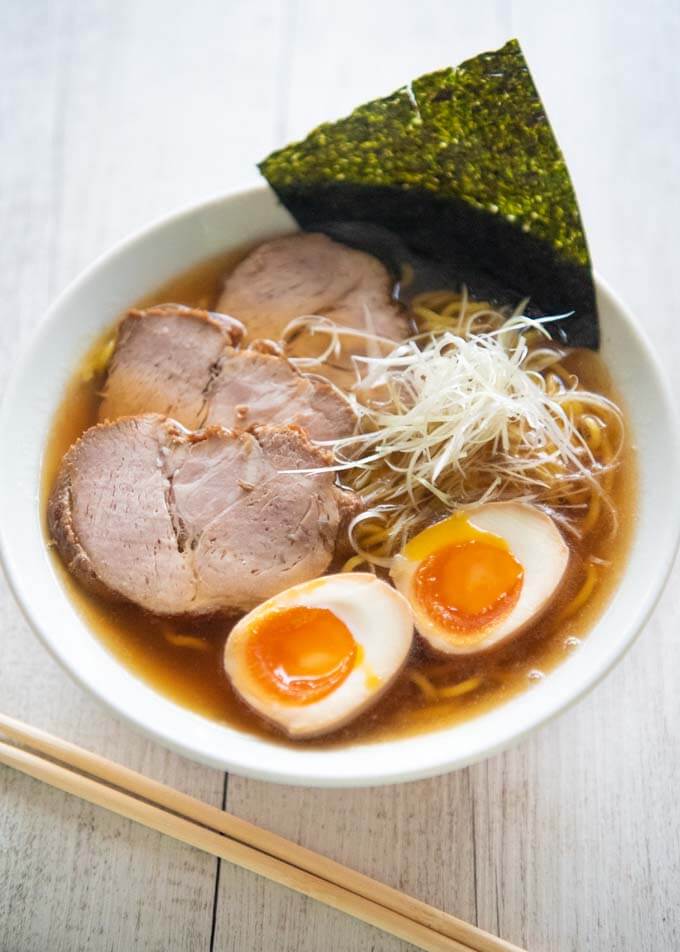
This Home-made Ramen Broth Recipe is one of the most popular recipes on my blog. So, I decided to republish it with a video showing how to make a broth on the stove top.
I thought of publishing a tonkotsu (pork bones) ramen but making a tonkotsu ramen broth is an extremely time-consuming process, requiring the broth to be simmered for a minimum of 6-8 hours, preferably 14+ hours. So to start with, I am posting a ramen broth that takes much less time to cook but still has a bit of tonkotsu flavour. It’s a kind of hybrid tonkotsu soup.
What’s in My Ramen Broth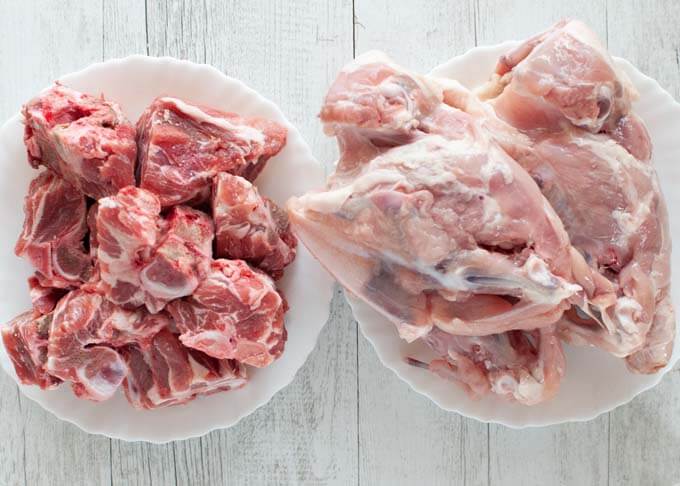
Real tonkotsu soup uses just pork leg bones. But I used chicken carcases and pork soup bones (the neck and back bones cut into smaller pieces). You will need about 1 kg/2.2lb of pork bones and 1-1.25kg/2.2-2.6lb of chicken carcasses to make 4-6 servings of soup.
- Chicken carcasses
- Pork soup bones
- A whole onion
- A few stems of green onions (green part)
- A cube of ginger
- A couple of cloves of garlic
- Bonito flakes

I add bonito flakes towards the end to give additional umami to the soup stock.
Keys to A Good Ramen Broth
If you let the bones and the other ingredients simmer for a long time, you will be able to make a soup stock. But it’s not going to be a good and tasty broth because coagulated blood on the bones and other unwanted substances gets mixed into the broth, making it extremely cloudy and degrading the flavour.
The following are the 4 key points to remember when making a good ramen soup stock:
- Blanch the bones and clean them first before cooking the bones for a long time
- Remove the scum as much as possible while cooking
- Simmer gently
- Do not mix the bones vigorously while simmering.
How to make Home-made ramen broth
In essence, you simply boil all the ingredients for about 2 hours. However, a few extra steps before and while boiling the ingredients gives you a clear and tastier broth.

- Bring water in a very large pot to a boil (I used a 7.2L stock pot) and blanch all the bones.
- Drain and clean the bones under running water.
- Put the bones and all other ingredients, excluding bonito flakes, in the pot.
- Add 4L / 8.5pt water to the pot and bring it to a boil.
- Remove the scum and reduce the heat to simmer.
- Simmer for 2 hours with a lid on, allowing for a small ventilation.
- Put bonito flakes in a spice bag into the pot and simmer for a couple of minutes.
- Turn the heat off and collect the broth through a sieve.
You can also make a ramen broth using a slow cooker or a pressure cooker, although the clarity of the broth is not quite the same – the slow cooker method produces clearer broth while the broth made in pressure cooker is a bit cloudy. See the instructions in the recipe card.
Ramen Soup Flavouring (Tare)
There are no seasonings added to the soup stock. When you taste it, you only taste the flavour of bones and vegetables, with a touch of bonito flakes.
If you have watched how the ramen shop makes a bowl of ramen, you probably know this, but the ramen soup is made by mixing the flavouring base with the ramen soup stock.

Soy sauce flavouring base.
This flavouring base is called ‘tare’ (タレ). Pronounce it as /tare/, not ‘/teː/’ or’ /teə/’. ‘Tare’ is actually a generic word for sauces that are made of two or more seasonings mixed together. The ramen flavouring base is hence called ‘ramen no tare’ to be accurate, but when the context of discussion is clear people simply call it ‘tare’.
There are many different tare and some unique flavours developed by Japanese ramen shops but all of them are based on the three common soup flavourings – salt flavour, soy sauce flavour and miso flavour.
Ramen with the soup made from these base flavourings are called ‘shio ramen‘ (salt flavoured ramen), ‘shōyu ramen‘ (soy sauce flavoured ramen – today’s ramen) and ‘miso ramen‘ (miso flavoured ramen). See my home-made base flavourings below.
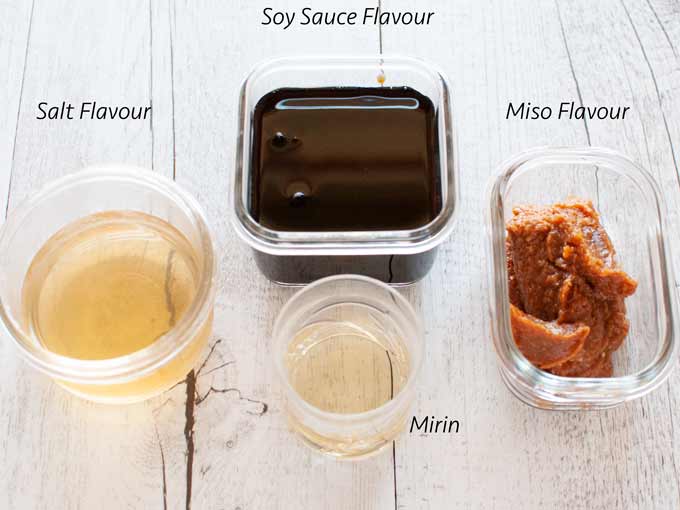
Even in making these flavourings, there are many variations. Since the soup stock does not have flavouring, the ‘tare’ needs to be quite salty and often contain some kind of umami. The ramen shops make every effort to create ramen ‘tare’ that are packed with umami and some of them take many days to make.
Simplest Soy Sauce Flavour
The easiest of my three tare is the soy sauce flavour and I have included short instructions for making shōyu ramen in today’s recipe.
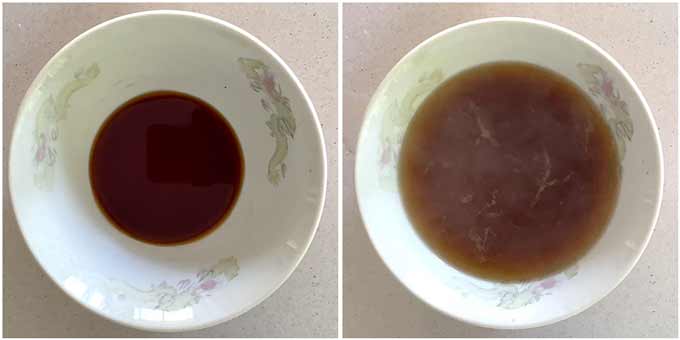
My soy sauce flavouring is made with just konbu (kelp) infused soy sauce (konbu soy sauce) and mirin. Soy sauce has umami in itself, but I thought adding konbu would boost the amount of umami. Simply add the Home-made Ramen Soup to the soy sauce flavouring base to make a shōyu ramen soup (photo above).
The method of making konbu infused soy sauce is in note 3 of the recipe below. You can find recipes for salt flavouring and miso flavouring in Home-made Shio Ramen and Home-Made Miso Ramen recipes. Today’s recipe is all about the ramen soup stock, but I added short instructions to make shōyu ramen (soy sauce flavoured ramen) using this soup stock.
My Home-made Ramen Broth is not as rich as tonkotsu ramen soup stock. It is surprisingly light, but full of flavour. I hope you try this.
Yumiko![]()
Watch How To Make It
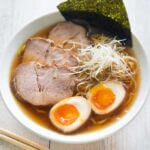
My version of Ramen Broth is made from a combination of pork bones, chicken carcasses and bonito flakes. It takes a few hours to make but it is not very difficult. You just have to be patient and pay attention to detail. (Watch the Video)
See notes 8 and 9 for making Ramen Broth using a slow cooker or a pressure cooker.
I also added instructions for how to make a soy sauce flavouring base to make shōyu ramen (soy sauce flavoured) soup. Also check out my Shio Ramen and Miso Ramen recipes.
Don't forget to see the section 'MEAL IDEAS' below the recipe card! It gives you a list of dishes that I have already posted and this recipe that can make up a complete meal. I hope it is of help to you.
- 1-1.2kg/2.2-2.6lb chicken carcasses (about 3 carcasses in total)
- 1kg/2.2lb pork soup bones (note 1)
- 1 onion , peeled
- 3 green onions green part only
- 3cm/1¼” cube ginger , cut in half
- 2 cloves garlic
- 10g/0.4oz bonito flakes in a spice bag (note 2)
- 2 tbsp konbu soy sauce (note 3)
- 1½ tsp mirin
- salt to adjust flavour
- 300-400ml/10-13.5oz Ramen Broth in this recipe , boiling hot
- 80-100g/2.8-3.5oz fresh thin egg noodles (note 4)
- 2-3 slices Yakibuta (Braised Pork)
- 1 Ramen Egg (Ajitsuke Tamago) , halved
- 2 tbsp shiraga negi finely julienned green onion, curled in iced water
- 1 10cm2/4"2 yakinori (roasted seaweed sheet)
-
Bring 4L/8.5pt of water in a pot to a boil. Add chicken and pork bones and boil for 10 minutes. A lot of scum will surface.
-
Drain and wash the bones under running cold water one by one, removing coagulated blood, guts along the spine of the chicken and other brown dirty bits.
-
Add the cleaned bones and the rest of the Ramen Broth ingredients, excluding bonito flakes, to a large pot with 4L/8.5pt water, and bring it to a boil.
-
When scum surfaces, occasionally scoop it off gently using a ladle (note 5). Do not mix the broth with the ladle when removing the scum as it will cause the broth to become cloudy.
-
After removing the scum 4-5 times, turn down the heat to simmer gently.
-
While simmering, remove scum a few more times in the beginning if required.
-
Simmer for 2 hours with a lid on but allowing for slight ventilation. Then add a bag of bonito flakes. Simmer for a couple of minutes.
-
Turn the heat off. Put the broth through a sieve and collect only the liquid.
-
Makes about 1.6L / 3.4pt of soup (note 6).
-
Put konbu soy sauce and mirin in a serving bowl.
-
Boil water in a saucepan, and cook noodles and drain very well.
-
Add Ramen Broth to the bowl and mix. Taste test the soup and adjust with salt.
-
Add the noodles. Place sliced Yakibuta, Ramen Eggs, and shraga negi on top and slide a yaki nori on the side of the bowl. Serve immediately.
1. My soup bones were back bones chopped into small pieces. If you have pork leg bones, that’s fine too. Ask the butcher to chop them in half.
2. Spice bags are usually made with muslin. If you have a piece of muslin, you can wrap bonito flakes in the muslin and tie the edges to make a bag just like bouquet garnis.
At Japanese grocery stores, you can also buy a pack of disposable dashi stock bags in which you can stuff bonito flakes and seal (see the photo below).
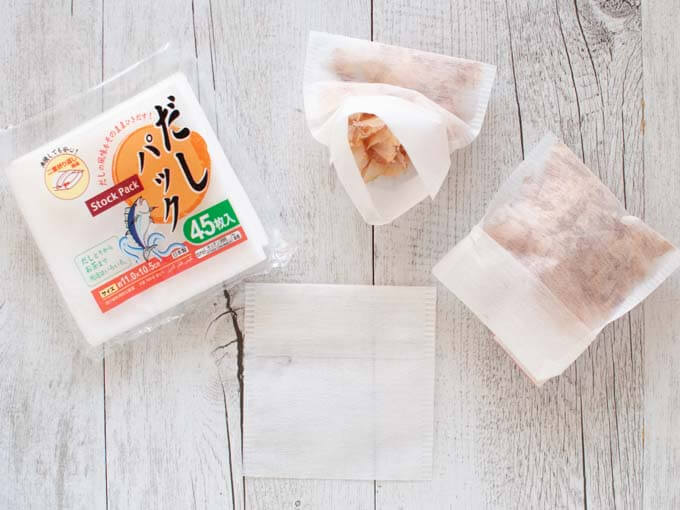
Alternatively, you can use a store-bought granular bonito dashi pack as long as it does not contain anything other than bonito flakes.
3. How to make konbu soy sauce (4 servings):
Cut 10cm x 5cm/ 4” x 2” konbu into about a dozen small pieces.
Add the konbu pieces and 120ml/4.1oz soy sauce in a jar.
Leave it in the fridge overnight up to 1 week.
If you don't have konbu, just use the same amount of soy sauce.
You can use konbu soy sauce in place of pouring soy sauce to the dishes, e.g. Chilled Tofu, Spinach Ohitashi Salad, Japanese Okura with Bonito Flakes.
4. Time to cook noodles varies depending on the type of noodles. You may also change the duration if you prefer the noodles to be firmer or softer. Follow the instructions on the pack as a guideline.
5. Instead of a ladle, you can use a flat sieve with fine mesh like this.
6. Depending on the diameter of the pot and the temperature of the cooktop, the amount of the broth you get varies.
If the water evaporates too fast, add boiling water to increase the quantity. If too much soup stock is remaining, cook further to reduce the quantity.
7. The topping of shōyu ramen is based on my recipe, Easy Japanese Rame Noodles. You can of course change the toppings to your favourites.
8. Making Ramen Broth using a slow cooker:
- After step 2, add bones, vegetables, and water to a slow cooker. You may not be able to add 4L/8.5pt of water if the slow cooker is not large. Add as much as possible and ensure that bones are submerged in the water. You can place the pork bones inside the chicken carcass. Alternatively, break the chicken carcass into smaller pieces.
- Set the slow cooker to low for 10 hours (preferred) or high for 6 hours. Because the broth is cooked slowly at low temperature, there should be hardly any scum.
- Put the broth through a sieve and collect only the liquid into a large pot.
- Simmer for 15 minutes or so to reduce the liquid to 1.6L/3.4pt. If there is not enough broth, add water to make it 1.6L/3.4pt.
- Add a bag of bonito flakes to the pot and simmer for a couple of minutes, then remove the bonito flakes.
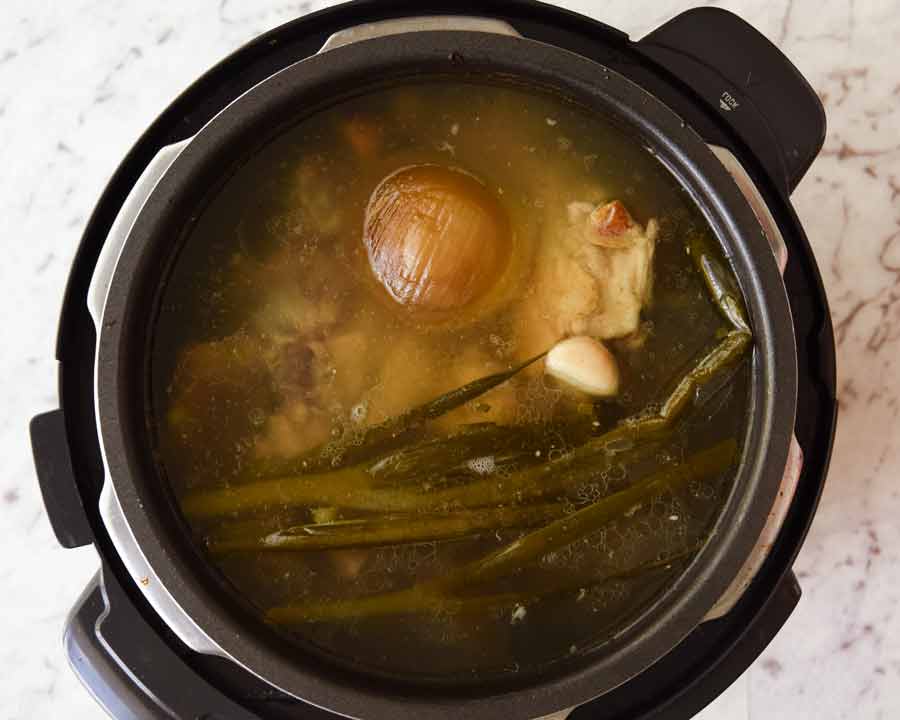
9. Making Ramen Broth using a pressure cooker:
- After step 2, add bones, vegetables, and water to a pressure cooker. You may not be able to add 4L/8.5pt of water if the pressure cooker is not large. I could add 3L/6.3pt.
- Follow the steps 4 & 5, then put the lid on over high heat.
- Pressure cook for 80 minutes. Turn the heat off and leave until the steam has naturally subsided.
- Put the broth through a sieve and collect only the liquid into a pot.
- If the liquid is more than 1.6L / 3.4pt, boil and reduce the quantity. If not enough broth, add water.
- Add a bag of bonito flakes to the pot and simmer for a couple of minutes, then remove the bonito flakes.
10. Ramen Broth can keep for a week or so in the fridge as long as it is brought to a boil every day and quickly cooled down, then place it in the fridge. You can also freeze the broth. It is more convenient to divide the broth into a serving size and freeze.
Originally published in October 2018, improved contents and added video in January 2022.
Meal Ideas
A typical Japanese meal consists of a main dish, a couple of side dishes, a soup and rice. I try to come up with a combination of dishes with a variety of flavours, colours, textures and make-ahead dishes.
When I order a ramen at a ramen shop, I always order a plate of gyoza. However, it is quite a challenge to serve both ramen and gyoza at the same time at home, since they both have to be served immediately while hot. If it is a challenge for you, I’d recommend Shumai (Steamed Dumpling) to go with the ramen instead. Shūmai can be reheated in a microwave.
- Main: Shōyu Ramen – today’s recipe Home-made Ramen Soup Recipe
- Side dish 1: Japanese GYOZA – from Nagi’s post in RecipeTin Eats, make ahead dumplings and cook when serving, or Shumai – make ahead dumplings and steam when serving
- Side dish 2: Scrmbled Tofu (Iri Dofu) – make ahead
- Salad: Tataki Kyuri (Smashed Cucumber Salad)
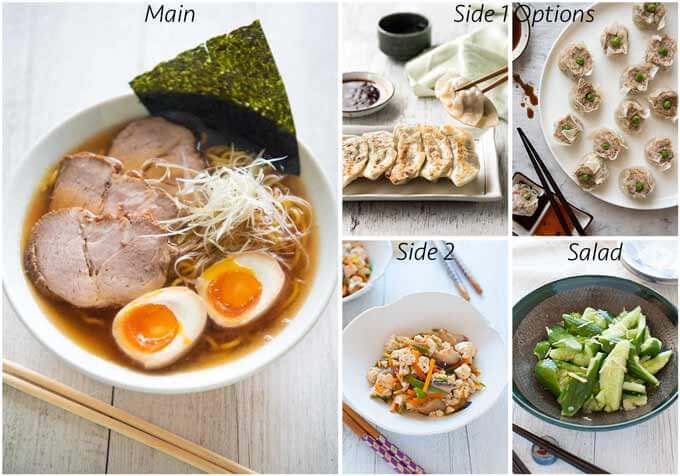
Where does one get chicken carcasses. And if I can’t get any, what can I do?
Hi Michael, you can buy them at Chicken shop or even some supermarkets. As an alternative, you can use chicken neck and chicken wings. chicken wings will extract more fat than chicken carcasses but the fat can be reduced by chilling the final broth and scraping off the white solidified fat on the surface.
Thank you very much for this delightful recipe.
we loved it 🙂
Hi Tal, great!
Hello Yumiko!
You have done a lot of work cooking, taking pictures and most of all, writing it all down.
The steps are authentic. I know, as I am a home cook and home cooks can spot missing steps
or incomplete recipes.
Thank you for sharing very detailed processes and thoughtful points. Sometimes, one can feel
very lonely as not everyone may understand the amount of washing, cleaning, chopping.. and the
sequence. Always thinking about the end at the start..!
Thank you, Yumiko…I appreciate your time & effort and sharing.
May you have wonderful cooking times, enjoying delicious, home cooked meals.!
Hi Ron, you are so kind and thank you very much. I do enjoy cooking, even if I have to cook same dishes many times because of mistakes in taking photos and videos!
My family loved this recipe & we are looking forward to trying more recipes from you.
Hi Jennifer, that’s great and thank you.
Hi Yumiko,
thanks for this recipe and the detailed instructions. Unfortunately I don’t have any chicken carcasses and won’t be able to get my hands on enough in time before the pork bones will have gone off (they were already frozen and i thawed them thinking i had a recipe on hand when it turned out i don’t). Can i omit the chicken carcass and replace with more pork bones?
Hi Steffi, you can use just pork bones to make ramen broth but you need to boil the bones much longer (minimum 6 hours) to get the flavour out of them. If you have a pressure cooker, you can use it and get it done in a couple of hours.
I’M GOING TO USE THE LEFTOVERS FROM MY THANKSGIVING turkey (i.e. carcass. And meat) instead of chicken.. how should I best intigrate that?
Hi William, that’s a good idea! Use it in place of chicken carcasses. If turkey carcass weighs more than the quantity of chicken in the recipe, you can even replace some pork bones with it. The broth might be slightly darker. Also, check the saltiness of the broth made. You may want to control the amount of salt in the flavour base accordingly.
If there are decent amount of turkey meat left, put some aside and use it as a topping.
Sounds delicious.
I have a pork allergy. What bones can I use in place of the pork bones?
Hi Toccarra, I would suggest that you replace pork bones with chicken carcasses. It will be a slightly lighter broth but equally good. Enjoy!
After I boil the bones for 10 minutes and clean bones under cold water and place in slow cooker am I’m using new clean water for adding to the slow cooker or do I use the seived water from when I boiled the bones?
Hi Jen, you need to use clean water. The first water is full of scum.
This looks amazing. You said that ramen broth could be simmered for up to 14 hours. could this recipe be simmered for longer then 2 hours?
Thank you
Hi Michelle, you can simmer longer. It makes the soup slightly richer too. But be aware that the quantity of the soup reduces.
Thank you for this! I can’t wait to follow the recipe and make a great ramen soon!
Hi Nyasha, please do and let me know how you went.
What are bonito flies?
Hi Claire, bonito flakes are the shaved dried bonito meat to get Japanese stock out of it. Please visit my post here, which talks about bonito with a photo.